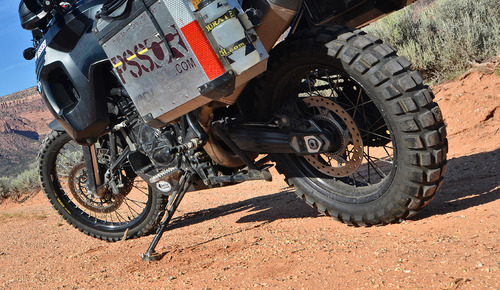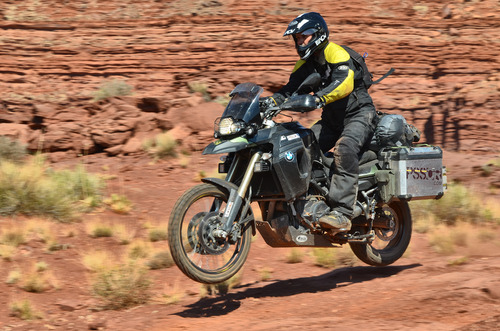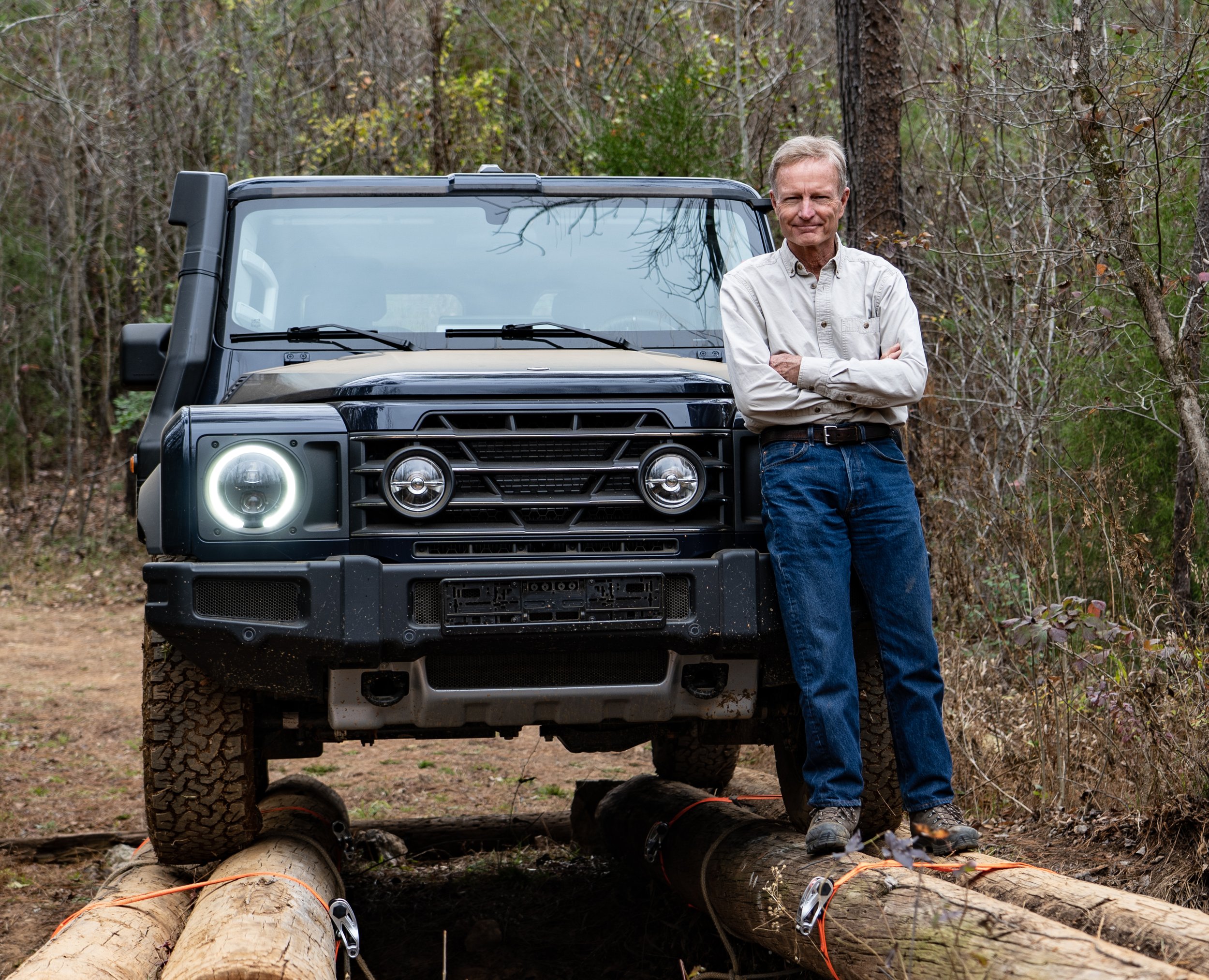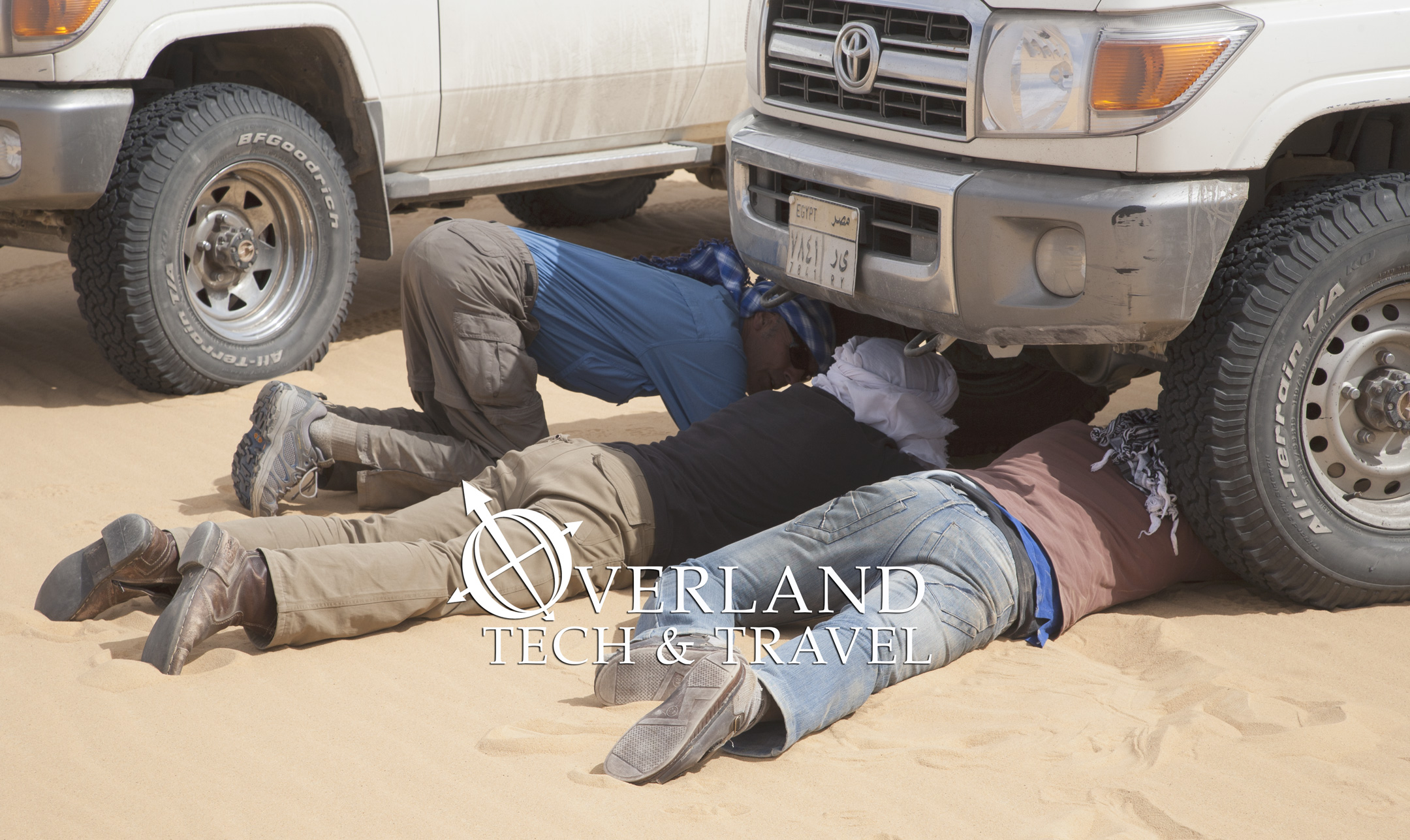
Overland Tech and Travel
Advice from the world's
most experienced overlanders
tests, reviews, opinion, and more
Last-minute gift ideas
 When it's 20 degrees Fahrenheit outside and the only adventure you can think of involves a warm drink in an armchair by the fire, it's time to grab some adventure reading:
When it's 20 degrees Fahrenheit outside and the only adventure you can think of involves a warm drink in an armchair by the fire, it's time to grab some adventure reading:

 HYBRIDLIGHT 150C, $50. This is the first solar-powered flashlight I’ve tried that produces a beam useful for more than reading or walking. Its 150-lumen output elevates it to the status of a practical security light—sufficient for, say, checking the bush for the eyeshine of hippos on the way from campfire to tent—and it will do so for eight hours on one charge. Not only that, the 150C can be stored for seven years with only a ten percent loss in charge. Need more? A USB and micro-USB port allow you to quick-charge the light—or charge your cell phone while the light soaks up energy from the sun. Hybridlight
HYBRIDLIGHT 150C, $50. This is the first solar-powered flashlight I’ve tried that produces a beam useful for more than reading or walking. Its 150-lumen output elevates it to the status of a practical security light—sufficient for, say, checking the bush for the eyeshine of hippos on the way from campfire to tent—and it will do so for eight hours on one charge. Not only that, the 150C can be stored for seven years with only a ten percent loss in charge. Need more? A USB and micro-USB port allow you to quick-charge the light—or charge your cell phone while the light soaks up energy from the sun. Hybridlight
 TEMBO TUSK EXTREME DUTY LANTERN HANGER, $95. If the idea of an “extreme duty” lantern hanger strikes you as humorous, you’ve never used some of the lame examples I’ve tried over the years. This one will last forever and effortlessly support your heaviest vintage Petromax. A mid-pole bracket takes a roll of paper towels, and auxiliary hooks hold kitchen utensils. The hanger disassembles into an easily stowable 12-inch-long case. TemboTusk
TEMBO TUSK EXTREME DUTY LANTERN HANGER, $95. If the idea of an “extreme duty” lantern hanger strikes you as humorous, you’ve never used some of the lame examples I’ve tried over the years. This one will last forever and effortlessly support your heaviest vintage Petromax. A mid-pole bracket takes a roll of paper towels, and auxiliary hooks hold kitchen utensils. The hanger disassembles into an easily stowable 12-inch-long case. TemboTusk

 BAJA RACK JEEP JK EXPEDITION RACK, $970. The Jeep Wrangler Rubicon is America’s world-class expedition vehicle, and Baja Rack manufactures a roof rack worthy of that stature. The full-length rack has a dynamic load capacity of 300 pounds (600 pounds static, if you want to stand on it for photography or game viewing), and mounts to the chassis and A-pillar of the JK with no drilling required. A flat platform in the rear is designed to accept a roof tent, and numerous accessories allow attaching everything from fuel cans to Maxtrax sand mats. Whether you’re pitting your JK against Moab or Mozambique, the Expedition Rack will live up to its name. Baja Rack (Also for Land Rover, Toyota, Mercedes, Hummer)
BAJA RACK JEEP JK EXPEDITION RACK, $970. The Jeep Wrangler Rubicon is America’s world-class expedition vehicle, and Baja Rack manufactures a roof rack worthy of that stature. The full-length rack has a dynamic load capacity of 300 pounds (600 pounds static, if you want to stand on it for photography or game viewing), and mounts to the chassis and A-pillar of the JK with no drilling required. A flat platform in the rear is designed to accept a roof tent, and numerous accessories allow attaching everything from fuel cans to Maxtrax sand mats. Whether you’re pitting your JK against Moab or Mozambique, the Expedition Rack will live up to its name. Baja Rack (Also for Land Rover, Toyota, Mercedes, Hummer) National Luna Weekender 52-liter fridge/freezer, $1470. I’ve never figured out why National Luna calls this the “Weekender.” It’s fully capable of handling enough food for a full-on expedition—as one just did for us on a three-week excursion through Tanzania and Kenya. We kept plenty of fresh food cold in the fridge, and the freezer compartment, in addition to maintaining ice cream at the proper chill, also handily re-froze blue-ice packs for Roseann’s sprained ankle. The aluminum cladding saves six pounds (and $180) over the stainless model, but as far as we could tell is just as rugged. The National Luna repays its premium price with a micro-processor controlled combination of fast chilling and extremely efficient energy usage. Equipt
National Luna Weekender 52-liter fridge/freezer, $1470. I’ve never figured out why National Luna calls this the “Weekender.” It’s fully capable of handling enough food for a full-on expedition—as one just did for us on a three-week excursion through Tanzania and Kenya. We kept plenty of fresh food cold in the fridge, and the freezer compartment, in addition to maintaining ice cream at the proper chill, also handily re-froze blue-ice packs for Roseann’s sprained ankle. The aluminum cladding saves six pounds (and $180) over the stainless model, but as far as we could tell is just as rugged. The National Luna repays its premium price with a micro-processor controlled combination of fast chilling and extremely efficient energy usage. Equipt FORCE K9 TACTICAL VEST, $150. It had to happen: A tactical dog vest. Kidding aside, the Force K9 vest’s PALS webbing allows easy attachment of a myriad of MOLLE accessories, from pouches suitable for Purina to water bladders. You can even have one custom-tailored to your Black Ops dog’s measurements. They’re missing a bet if they don’t introduce a doggie shemagh. Force K9
FORCE K9 TACTICAL VEST, $150. It had to happen: A tactical dog vest. Kidding aside, the Force K9 vest’s PALS webbing allows easy attachment of a myriad of MOLLE accessories, from pouches suitable for Purina to water bladders. You can even have one custom-tailored to your Black Ops dog’s measurements. They’re missing a bet if they don’t introduce a doggie shemagh. Force K9
 OVERLAND TRAINING, $CUSTOM. The gift of training keeps giving for years, in confidence and competence down the road. May we suggest a couple of our partners for great training experiences: Through teamwork and the execution of strategic decisions in naturally challenging settings, High Trails Expeditions will teach you and your team—whether business or expedition—how to understand the consequences of actions to yourself and others. This is the ultimate leadership course built for people like us, around overland skills. If your passion is adventure motorcycling, then look no further than Jim Hyde's offerings at Raw-Hyde Adventures. Now with an outpost in southern Colorado's Continental Divide country as well as SOCAL, you can learn with the best, in the most beautiful places. High Trails Expeditions, Raw-Hyde Adventures.
OVERLAND TRAINING, $CUSTOM. The gift of training keeps giving for years, in confidence and competence down the road. May we suggest a couple of our partners for great training experiences: Through teamwork and the execution of strategic decisions in naturally challenging settings, High Trails Expeditions will teach you and your team—whether business or expedition—how to understand the consequences of actions to yourself and others. This is the ultimate leadership course built for people like us, around overland skills. If your passion is adventure motorcycling, then look no further than Jim Hyde's offerings at Raw-Hyde Adventures. Now with an outpost in southern Colorado's Continental Divide country as well as SOCAL, you can learn with the best, in the most beautiful places. High Trails Expeditions, Raw-Hyde Adventures. TRIUMPH TIGER 800 ABS, $11,000. The reborn Triumph motorcycle company has risen to the same legendary status as its progenitor did half a century
TRIUMPH TIGER 800 ABS, $11,000. The reborn Triumph motorcycle company has risen to the same legendary status as its progenitor did half a century 
 The perfect gift: Overland Expo 2014. Give the gift of 300+ session-hours of classes, programs, demos, discussions, and films; shopping close to 200 exhibitors of adventure gear and services; and meeting thousands of like-minded adventurers. Still a bargain at $270 (single), $485 (double)
The perfect gift: Overland Expo 2014. Give the gift of 300+ session-hours of classes, programs, demos, discussions, and films; shopping close to 200 exhibitors of adventure gear and services; and meeting thousands of like-minded adventurers. Still a bargain at $270 (single), $485 (double) Dual-Sport Adventure Touring Motorcycle Boot Review by Carla King
by Carla King (carlaking.com)
After my second dual-sport ride my poor little Tour Master street boots were trashed. My friend's motocross boots fit okay, but they were too heavy and noisy to walk in. It was clearly time to go shopping. Looking through the crop of serious four-season, full-height, dual-sport adventure-touring boots, I decided that boots with the features I was looking for ranged from $350 to $550 in price. After a couple of months grilling the adventure riding community about their choices, I decided on the TCX Infinity GTX (Gortex) adventure touring boots, formerly branded Oxtar. This is a review of the TCX Infinitys and it's followed by a review of my shopping experience that includes descriptions of competing boots with reasons for eliminating them from my list.
Above is a series of photos of my first try-on of the boots. (Click to enlarge.) They were easy to put on, the buckles are very adjustable, and I like the elastic collar at the top. I also like the understated look of them. I'm wearing my Olympia Moto Sports Mesh Tech jacket and pants. The pants unzip all the way to the hip making it very easy to put on and take off your boots.
The Contenders
- TCX Infinity GTX Boots $359, X-Desert $399
- Aerostich Combat Touring Boots $367
- Gaerne Balance Oiled Boots $395
- Forma Adventure Boots $299, Boulder $279, Cape Horn $299
- SIDI Discovery Rain Boots $350, Adventure Rain $400, Adventure Gore-Tex $550
- Alpinestars Toucan Boots $449
- Dainese Carroarmato Gore-Tex Boots $369
Standard on most of these boots are ski boot-type buckle closures, sturdy heel and toe cockpits, and reinforced material that protects the ankles. They're all tall boots, and most have additional padding along the front that protects you from the commonly experienced shin-to-footpeg bashing syndrome. Features I was looking for specifically included:
- A tall boot with shin protection
- Sturdy heel and toe compartments
- Stiff ankle area (little side-to-side bending allowed!)
- Solid protection for the malleolus (ankle bones) on each side of the foot
- Waterproof breathable Gore-tex or similar material
- A padded elastic collar around the top to keep out rocks and dirt and water
- Maximum flexibility for walking
- Sticky sole for street, dirt and mud
- Footbed strong enough to stand comfortably on the pegs
- Understated look, no logos
- Ease in putting them on and taking them off
Picture This
I collected the boots into lookalike groups (see photo below, click to enlarge) because I think most of us have an idea of the "look" we want. Simple or complex, sleek or clunky, old school or hi-tech, black or brown, understated or colorful. I hope that the review of the boots I chose in combination with my shopping experience and this pictorial comparison of boots with prices will help you choose the right pair. I'd love to hear your thoughts, your concerns, frustrations, compromises, and your experience with boots of your past, present, and future. Did I leave your favorite boots out? Do you agree or disagree with my impressions? I know this is a hot topic, so I look forward to hearing from you in the comments area at the end of this article or via the contact form on my website, or join the discussion on my Facebook page. 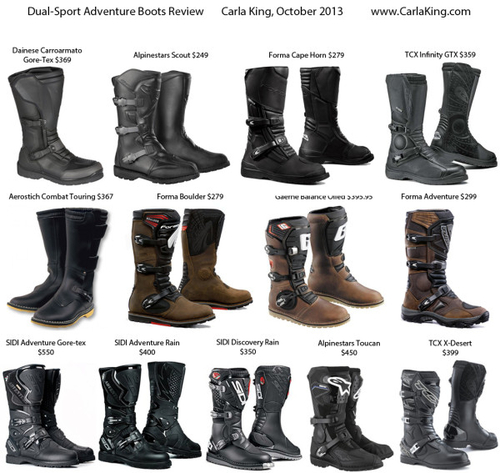

TCX Infinity GTX Boot
The TCX Infinity GTX is classified by the company as a "touring adventure" model. It fit my requirements for a dual-sport adventure touring boot crafted from waterproof yet breathable material with an elastic collar at the top to keep out water and debris, a quick and very adjustable buckle and velcro closure combination, a sturdy sole that would not slip on rocks, street, or mud, a flexible heel, and enough comfort to take a short hike. I also liked their understated look in comparison to the clunkier (and more protective) models I looked at. TCX Infinity customers consistently report 100% satisfaction with their boots, without the "buts" or "if justs" that riders wearing other brands often mention. To further recommend the TCX, many told me that they are loyal second- and third-time buyers who purchased the Infinity after many years of dual-sport riding in their Oxtars. (Oxtar was rebranded TCX after the acquisition of the company by Novation S.p.A. based in Montebelluna, Italy.)
SIZING

Let me first state that I can wear men's sizes because I have a wider foot than the average woman. Luckily for me, most boots start at at European size 40, a woman's size 9. The TCX starts in size 38. However, most stores stock size 42 and up, but can order them from the factory. Plan ahead, because this can take six weeks or more. My size 40 with a cushy sole insert fits great. I put them on and forgot about them, and that's the best recommendation I can give for any piece of gear. As I mentioned in my review of the Schuberth C3 modular helmet, the best gear both protects you from a possible mishap and provides enough comfort to forget about it and enjoy the ride.
WOMEN'S SIZING
Women who wear smaller than size 38 and women with narrow feet will not be able to wear the TCX Infinity or any of the boots mentioned in this review. The boots I shopped for were designed for men, which means they are constructed for wider feet in larger sizes. (I never appreciated my feet so much until now!) The pickings for women in the dual-sport and adventure category are slim. All I could find were SIDI's Vertigo Lei and Fusion Lei, which are, of course, compromises. As a side note, I hope that the industry catches on to the numbers of women who want boots in this category. The number of women who attend adventure motorcycle events like Overland Expo, Horizons Unlimited, and the Carson Valley / Tahoe Adventure Rendezvous is approaching fifty percent and we're all wearing boots designed for men's feet.
SAFETY FEATURES
The TCX Infinity had all the features I wanted: Reinforced heel and toe cockpits, stiff ankle area with malleolus protection on both sides, sturdy footbed and sticky sole, shin protection, reinforced toe and heel cockpits, rubberized shift guard, two cam-lock buckles, thermal heat-resistant suede on the inside of the shin, a velcro closure, and a Gore-tex fly or gaiter.
FOOTBED AND SOLE
All TCX boots are made with an anatomic, replaceable footbed that is manually fitted around a foot-shaped mold. There is no break-in period, and the boot flexes easily at the front and back of the heel. This means walking is comfortable, though the footbed is stiff enough that you wouldn't want to trek more than about a mile without a break. It's stiff enough to stand on the footpegs for hours but, unlike many of the stiffer MX boots, you can still feel the pegs under your feet. The sole is patterned in a sticky black tire-tread pattern that channels water out to the edges so you don't slip in water and mud.
COMFORT
The boot feels custom-fitted with its combination of adjustable cam-lock buckles, the wide velcro closure, and the padded elastic collar. It fits snugly with your pants in or out of the boot, or even with a motocross knee and shin guard tucked inside. A couple of inches of Gore-tex on the inside at the top of the boot keeps the foot cool and dry. In the past few months I've ridden in both very hot and very cold conditions, through water crossings and across desert sands, and on miles and miles of tarmac, with no discomfort at all.
RIDING IN THE TCX INFINITY
I throughly tested the safety features of the Infinitys at the Carson Vally / Tahoe Adventure Motorcycle Rendezvous in August. The first ride was a challenging day along the boulder fields and shale trails far into the hills and valleys. I opted for the "medium-level" off-road instead of "beginner," but it turned out to be a rather advanced run. Still, I made it, after bouncing off a few times (at slow speeds). This amused most, but irritated a few, of my fellow riders. And they were all fellows, making it all the more embarrassing for the sole woman in the group, even after one rider was trucked out after a collarbone-breaking fall 18 miles into the hills. Because someone else rode my bike down a particularly steep descent, I can also attest to their comfort while picking your way down a rocky trail. 
Yeah, yeah, I see the boulder. Now where's my bike?
REPLACING MY STREET BOOTS?
Since then I have instinctively chosen the TCX Infinitys over my comfy but battered old Tour Master street boots, even for all-tarmac rides. It's pretty clear to me now that I will never go back to street boots. Today's touring boots have so much protection embedded into a not unstylish product that I don't find it necessary to choose. In comparison, the street boots, though they're safety conscious in their class, seem much too short and flimsy. Perhaps if I had chosen one of the more clunky models made with a lot of TPU (Thermoplastic polyurethane) like the SIDI Rains ($350-$400), Alpinestars Toucan ($449), or TCX's X-Desert ($399) I wouldn't be as willing to wear them for a spin on my Guzzi cruiser. But I think the Infinitys are good looking enough to pass for cruiser wear.

I choose the TCX Infinity boots over my street boots when I cruise on my Guzzi.
OTHER OPTIONS FROM TCX
If you're the kind of rider with multiple bikes and multiple sets of gear, you're going to love looking through the stylish selections that TCX offers. The brand provides a full range of foot protection for all kinds of riders including categories for custom bikes, street, touring, enduro, motocross, and ATV. I especially like their high-top sneaker style boot. Check them out. They have a great reputation for comfort, safety, and style. 
I also glanced briefly at the TCX Touring Adventure / X-Desert Gore-text ($450) with lots of plastic hard parts, but they were too clunky for my taste. Riders attracted to the Alpinestars Toucan or the SIDI Adventure series should take a look, though. If you're on a budget, consider TCX's Track EVO Waterproof boots. They have all the safety features, are lightweight, and the $239 price point is rather surprising. They're waterproof but without breathable Gore-tex those prone to swamp foot will need to pass.
THE SHOPPING JOURNEY
Because shopping for gear is such a journey, I'd like to share it with you, explaining why I eliminated the contenders from my list before I decided on the TCX Infinity. 
AEROSTICH COMBAT TOURING BOOTS
I'm going to start with the Combat Touring boots ($367) made by SIDI for Aerostich, which are a very popular boot with the adventure riding crowd. People love their Combats but there are several reasons I ruled them out. First, though they're padded, they are the only model that does not have a reinforced shin guard on the front of the boot, and I seem to hit my shins on the pegs a lot when I'm riding off-road. So the Combat seemed to me to target the dual-sport rider who rides the occasional fire road, unlike most of the others in this quality/price point, which offer true off-road protection in the single-track class. Another factor that determined that this boot was not for me had to do with the fact that it's made entirely of untreated leather. It's incredibly heavy, stiff, and difficult to walk in until a very long and painful (according to many reviewers) break-in period. I think there are two camps when it comes to boots: high-tech and old style. I love sloshing through puddles and mud and being able to just hose them down and forget them between rides. I'm not crazy about the constant maintenance involved in keeping leather soft and waterproof. The Combat is fastened by a single buckle at the ankle which, in comparison to the other boots, seems unusually stingy for a boot in this class. Many reviewers report that the dual velcro fasteners wear out, too. I wonder why they don't add a second buckle, like most everyone else, with a single velcro fastener at the top? On the Combat, adjustment depends upon a lace-up cord between the outer and the gaiter that looked to me to be fumbly and futzy. Indeed, reviews commonly state that the laces stick to the velcro closure, which eventually frays them into oblivion. But the feature I loved on the Combats was the elastic collar at the top. Brilliant! When I saw it I remembered how, on a recent ride through a deep water crossing, water literally poured into the boots I was wearing. I imagined that this elastic collar would solve that problem, along with deterring the large quantities of pebbles and sand I was constantly dislodging from my borrowed MX boots. In the end, two factors killed the Combats for me: Lack of safety features, and the leather material. Leather's lack of immediate-gratification flexibility requiring a long break-in period and constant maintenance. Not to mention the lack of a breathable Gore-tex lining. The Combat is a 100% old-school boot. Enjoy, luddites! 
GAERNE BALANCE OILED
When I put the word out on Facebook that I was shopping for adventure touring boots, I received more recommendation for Gaernes than any other brand. I'd already ruled them out for many of the same reasons I ruled out Aerostich's Combats, but wow, do they ever have a wildly dedicated fan base. The consensus is that the break-in period is almost non-existant, they're lighter, extremely comfortable, and they're brown, not black. I wouldn't mention this except that so many men point out the rugged mountain-man look of them. "The kind of boot Steve McQueen would wear," was one review. This glimpse into male vanity gave me a little laugh, but I understood. They do have a "rock-star adventure rider" vibe about them, and I'll bet they look great with one of those workmen's kilts. Gaerne's Balance Oiled boots ($369) are pre-oiled and fully waterproof right out of the box. They claim that oil-tanned leather is more breathable than the PU (polyurethane) coated leather that "modern" boots use, and the "Aquatech" membrane inside keeps your feet totally dry. Originally created for trial riders (hence the name "Balance"), this model has hard inserts in the heel and toe but no reinforcement in the ankle. This means they are a bit too bendy for someone in the habit of putting herself at risk of frequent dual-sport get-offs. However, the leather is much thicker than street-boot leather and, in combination with the interior padding, gives you a fair amount of cushion. Like most of the modern, high-tech boots I looked at, the Balance Oiled do have three buckles and a shin guard. Resellers tout it as the most comfortable boot they've ever worn, claiming a five-mile hike is not a problem. Gaerne also uses a modified MX boot midsole that's reportedly stiff enough to protect against folding when striking a hard object, but flexible enough to feel your footpegs. I must admit that the combination of old and new school features tempted me, even in spite of my logo-itis -- they put a big white G across the front. What to do? Probably just have a go at it with my fat black Sharpie. Sizes start at an American 8, but smaller sizes are available by special order for about $40 more. A budget version of this boot is the Gaerne Pro-Tech ($284) which is not waterproof. 
FORMA ADVENTURE
Such are the consequences of timing that if Forma had been on my radar when I was shopping for boots, this review may have featured their Forma Adventure boot ($299), with the TCX Infinity description placed about here. Forma is very popular in Europe and Australia but virtually unknown in the USA because they didn't have a US distributor until recently. Like the Gaerne, the Forma Adventure is made from beautiful pre-oiled leather and it comes in brown or black. Plus, it has all the hi-tech features of the TCX and others in this roundup: adjustable buckles, a shin plate, and sturdy heel and toe compartments. It's a beautiful combination of old school and new tech and I definitely want to try it on. The Drytex liner in Forma boots is, like Gore-tex, completely waterproof and breathable. It has great ankle support with molded inserts on the inner and outer ankle. So it's rigid and supportive, but built for comfort. In fact, it's more flexible at the toe than other adventure boots, and fans say it feels much more like a hiking boot. This really attracts me because I, like a lot of adventure touring folks, like to spend a significant time off the bike to explore, whether it's a short hike in a state park or a trek through a new town. Retailers stock sizes starting at 42 but you can special order sizes 38-41. And for you Steve McQueen types, yep, it also comes in brown. The only down side for me is that the Formas, like the Gaernes, Alpinestars and one of the SIDI models, suffers from logo-itis. Honestly, I'd pay more for a version without logos. For $20 less you might consider the Forma Boulder ($279), which does not have waterproof, breathable lining, but the untreated breathable nubuck suede leather is naturally breathable. If you like the look of the TCX Infinity but it's too expensive for your budget, take a look at Forma's Cape Horn ($299) touring boot, which looks a lot like it, though it lacks the elastic collar and the same level of heel and toe reinforcements. 
SIDI RAINS
I have a few friends who have invested in SIDI Adventure Gore-tex ($550) and swear that everyone else should wear them, too, even though they complain loudly about the squeak. In fact there's an entire thread on "The SIDI Adventure Squeak" in ADVRider, with wearers recommending solutions from furniture polish to baby powder. The SIDI squeak is background music at any adventure motorcycle event, no apologies required. But with all the complaints on this defect I can't imagine why SIDI hasn't solved the problem, especially as their boots are among the most expensive in the bunch. If they don't do something about it soon, I predict that all the other manufacturers will start to brag about their anti-squeak technology. The feature set of the more expensive two versions of this boot - the Adventure Gortex and the Adventure Rain - seemed too over the top for me, too "MX" for the kind of riding I'd be doing. Very reinforced. Lots of plastic. Clomp clomp. But unlike the SIDI Adventure Gortex ($550) or the Adventure Rains ($400), the Discovery Rain ($350) has the coveted elastic collar around the top, which made me look twice. (By the way, the SIDI website no longer lists the Adventure Rains, so they may have discontinued the model. However, many of the superstores still carry them.)  I was tempted, but in the end did not choose the Discovery Rain because of 1) the SIDI squeak and 2) logo-itis. I simply do not like wearing corporate logos. Logos on the more expensive Adventure Gore-tex and Adventure Rains are more subdued. The Discovery Rains have large white letters emblazoned across the front of the boot. To further complicate the shopping experience I discovered SIDI's Armada Gortex ($400), a beefy and good looking waterproof "convertible" boot in black leather with Gore-tex lining. The outer dual-sport sleeve provides ankle and shin protection and, once removed, reveals a fully-finished, good-looking cruising boot.
I was tempted, but in the end did not choose the Discovery Rain because of 1) the SIDI squeak and 2) logo-itis. I simply do not like wearing corporate logos. Logos on the more expensive Adventure Gore-tex and Adventure Rains are more subdued. The Discovery Rains have large white letters emblazoned across the front of the boot. To further complicate the shopping experience I discovered SIDI's Armada Gortex ($400), a beefy and good looking waterproof "convertible" boot in black leather with Gore-tex lining. The outer dual-sport sleeve provides ankle and shin protection and, once removed, reveals a fully-finished, good-looking cruising boot.
ALPINESTARS TOUCAN GTX
The Alpinestars Toucan ($449) is well-respected for their MX line. The Toucan is rich with safety features and it's also an extremely light weight boot at 2.12 lbs. You'd think that a boot of this weight would have greater flexibility but actually they're quite stiff, and they also lack the elastic collar around the top edge. Like the SIDIs, they were somewhat clunkier than I could live with. If you like this boot but can't afford the $449 price tag, take a look at their Scout model at $249. Also take note, the Alpinestars don't squeak. 
DAINESE CARROARMATOA GORE-TEX
I don't know anyone who wears the Dainese Carroarmato Gore-Tex boots ($369) but they're gorgeous and very comfortable. I might have considered them except that I was by now committed to the idea of that elastic collar around the top of the boot. I would certainly recommend taking a look if you're more street touring oriented than dirt. These boots are so good looking that you could wear them with normal clothing, and they also come in white with turquoise buckles. Now that's Italian!
A SEEMINGLY UNLIMITED SELEC
The range of dual-sport or adventure boots is staggering, and this selection is as far as I got without getting completely overwhelmed. I know people who wear BMW's dual-sport boots and they probably belong in this lineup, too, but they don't advertise online and I didn't get to the dealer. If you bought a BMW from a dealership, you may well have them, along with a lot of other branded BMW gear. What other boots did I leave out? Offerings from Europe - Wulfsports, for example, which a few of my British friends love. What boots do you love that I left out? I'd love to hear about them in the comments section at the end of this post. I'll also continue the discussion on my Facebook page.
Recommendations
The overlap in touring, dual-sport, adventure touring, trials, and motocross is as varied as there are companies who provide them. Most of the trials boots I looked at online seem to have more protection than the Aerostich Combat boots, which are marketed as adventure touring boots. Your decision will vary according to the type of riding you do, size, weight, style, and price. I think the final decision comes down to these three factors:
- Safety - What features can't you live without? Mine included shin guards, heel and toe reinforcements, and ankle protection.
- Riding style - I ride mostly street and dirt roads, with enough technical trail riding to warrant seriously protective gear. And I aspire to ride more dirt. But if you ride mostly street with the occasional fire road you'll need less protection than someone who rides to search for good single track.
- Price - Adventure touring boots are expensive, but even if you need to watch your budget you don't need to sacrifice safety. There are plenty of options in the less expensive trials and MX boot categories to choose from. And don't forget Craigslist, eBay, and check out the selection of used gear in my friend Jessica's Yellow Devil Gear shop in Los Angeles. She ships!
Final Thoughts
Despite lusting a bit over the Forma Adventures and the SIDI Armadas, I don't regret choosing TCX Infinity. They've already proven themselves on long tarmac rides and single-track challenges. They've protected me from a fall in a boulder field, from a slide on shale, from water crossings and desert sands. I have forgotten that I'm wearing them for very long periods of time. Cleaning them requires a quick swipe with a sponge and the occasional touchup with black shoe polish. And they're understated enough that I can get away with wearing them off the bike with tights and a skirt. In adventure motorcycle touring, less is more, so if I wear these and pack my flip-flops, well then, it looks like I'm ready for Baja.
Join the Discussion
What boots do you wear for adventure touring? Join the discussion.
JATAC gets an outdoor kitchen
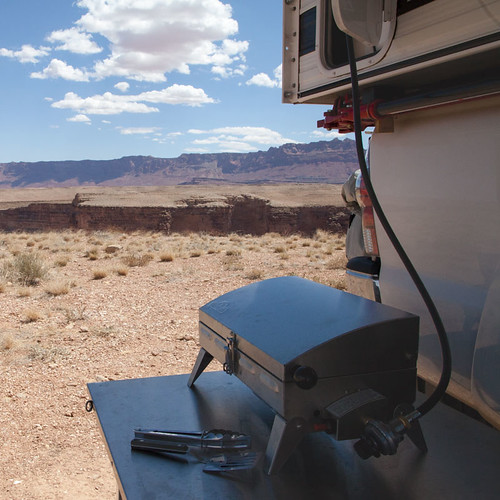
by Roseann Hanson (co-director, Overland Expo)
There's a lot I love about having a stove, sink, and fridge inside a truck camper—all-weather cooking, protection from mosquitoes, and the convenience of a full kitchen (see this article, about our "Just a Tacoma and Camper" setup). But I miss cooking outside. It's more social, and enjoying the views is why we explore and camp. Nothing like sipping a cool drink, tending some thick pork chops, and gazing out over the Grand Canyon while a condor soars overhead . . .
To facilitate outdoor cooking, we sorted out a camp table and awning. Jonathan rigged us a sleek and easy mount for the sturdy stainless steel table from Frontrunner Outfitters (see story here). And although it was initially a tough decision ($800), we invested in a high-quality, quick-deploying Fiamma awning for the starboard side. Importantly, this is also the side for access to the Four Wheel Camper's dual 10-pound propane tanks, since I settled on a propane grill, for convenience and when local fire restrictions or wood availability obviates our Snow Peak portable fireplace grill. My idea was to leave one tank hooked up to the inside stove and hot water heater, and the second tank rigged with a portable grill hose so all we had to do was hook it up and start cooking.
Now all I needed was a portable propane grill that was powerful, not too bulky, high-quality, and functional.
Easier said than done. I looked at many name brands, including Coleman, Char-Broil, Weber, and NexGrill (a sister brand of Jenn-Air). Some had great BTU ratings (the NexGrill boasts 20,000 and has 2 burners with separate controls). Some were clever (the Coleman Road Trip has an integrated stand that scissors down, so you don't need to use up valuable table space). Some were cheap (the Char-Broil at $30 via Amazon—with the savings you could buy a lot of top sirloin . . .). Some were compact (the Fuego Element closes like a sleek clamshell and is just 9x12).
But in the end my eye was caught by the Napoleon PTSS165P portable grill ($189 MSRP), built for the demanding marine environment (you can order very pricey sailboat cockpit mounts for it). Runner up was the NexGrill (model 820-0015, $180 at Home Depot) but reviews on Amazon indicated the finish quality was poor, with some users claiming not all parts are stainless, or were flimsy with sharp edges. The quality of the Napoleon looked so good, I decided to take a gamble on its 9,000 BTUs (compared to twice that for the NexGrill) and single burner control.
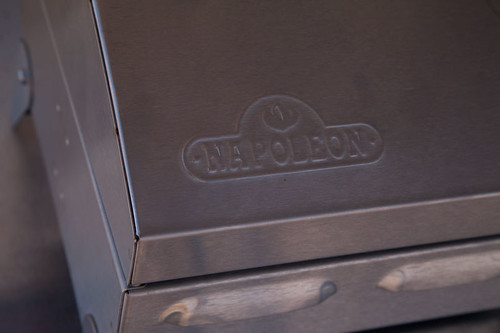
The finish quality of the Napoleon is beyond reproach: folded and riveted corners, smoothly finished vent holes, and sturdy (not at all "tinny") 304 stainless throughout.
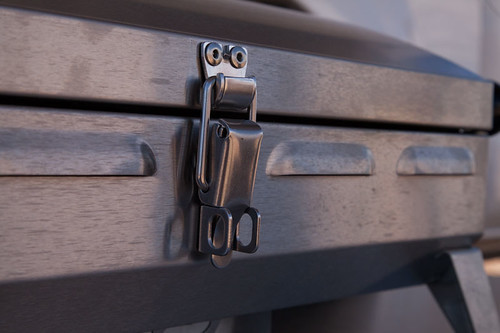
Details like the high-quality latch and rivets won me over.
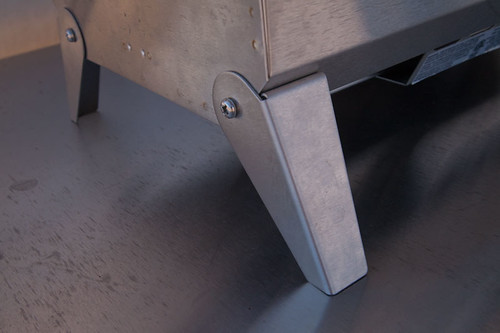
The four-inch legs are anchored with stainless bolts, and pivot flush to the bottom for storage. Only complaint: they do scratch the tabletop, so we're going to coat the bases in Plasti-Dip.

The handle stays cool even after long periods of cooking. However, it's on the wrong side for a right-handed person (when grilling, you usually hold a utensil in your right hand and would use your left to open the grill to check cooking progress). The pietzo-igniter stopped working after the first night. The propane regulator is also on this side. The Napoleon only comes with a mount for small 1-pound canisters; we had to buy a 5-foot hose to connect it to our 10-pound tank.
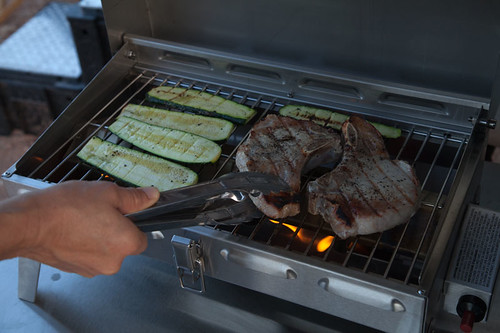
Cooking area is 17.25 x 9.25 and just about perfect for two people. For more food than that, cooking in shifts would be recommended. To get searing temperatures, the instructions recommend lighting the grill and pre-heating for 10 minutes. This did produce temperatueres just right for searing the pork chops. I do wish it had two burners so I could turn one off to create a cooler location for finishing things like vegetables.

The slightly domed lid is vented but very windproof (we cooked two dinners in 10-15 MPH gusts), and its height would allow cooking a small whole chicken or something in a deep-dish pan; you could even bake a cake or low-top bread. There is a slide-out grease trap tray on the bottom, which made clean-up super easy.
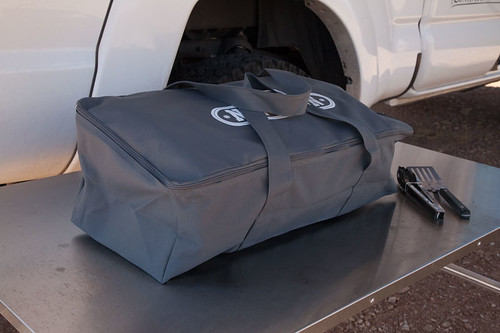
The carrying case fits well but its quality is not commensurate to the grill: the fabric is thin Cordura and is poorly sewn (on ours, the inside pocket for the gas regulator pulled out at the bottom), so I'm not expecting it to last as long as the high-quality grill.
We've now used the Napoleon half a dozen times on a 2,800 mile trip, and are overall extremely pleased with the quality. It's also transformed our camping by doubling our "living area" to include a spacious, convenient, shaded outdoor kitchen where we can easily grill salmon steaks, cook lasagna, bake a cake, or turn out bacon and pancakes on a griddle for a small group.
(Awning: Fiamma.com; table: FrontrunnerOutfitters.com or a similar version from K9 racks and Equipt Expedition Outfitters, available in three sizes)
Schuberth C3 helmet: 12 months and 10,000 miles review
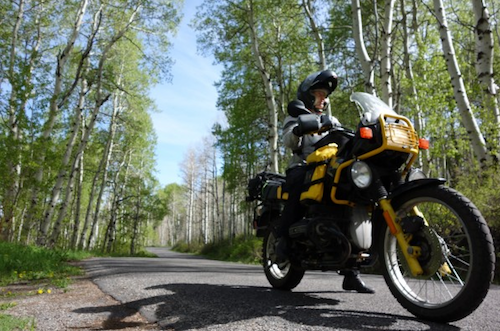
by Carla King, CarlaKing.com
My last helmet squeezed my jawbone, giving me a headache after about an hour. The previous one pressed on my left temple. Another rattled, another fell forward over my eyebrows, and yet another let a constant stream of air up the back of my neck. Helmets have made me itchy and sweaty, the visors have popped off, and the air flow controls have never quite worked properly. I've worn half-helmets, full helmets, modular helmets, dual-sport helmets, other people’s helmets, cheap helmets, medium-priced helmets, and expensive helmets. But in Spring of 2012 I started wearing a Schuberth C3, and since then I have stopped to look at a view, to ask directions, to fill up my gas tank, to buy snacks at a convenience store, to make phone calls and to take photos, all with my helmet still strapped on.
 WHY MODULAR?
WHY MODULAR?
I’ve always liked the idea of a modular helmet. I travel a lot and interact with people on the road, and it’s nice to be able to slide up the chin bar so people can see my face when I’m talking with them, especially when attempting a foreign language. But helmets have always been so uncomfortable that I've removed them every opportunity, sighing "aaahhhh" in relief from pressure-points, itching, and sweating. The Schuberth C3 is the first helmet I've owned that I don’t rip off my head as soon as the wheels stop turning, and that’s saying something, because I have been riding since I was a teenager.
Continue reading the full review here.
We will be running more motorcycle and equipment reviews from Carla, a longtime Overland Expo instructor and one of the most accomplished riders we know. Carla's been riding motorcycles since she was 14, and has ridden every kind of bike on most continents.
Tire review: Big Block Adventure
by Bret Tkacs, for Adventure Motorcycle Magazine
In early 2012, Kenda released the Big Block Adventure tire to compete in the emerging big-bike knobby market. ADVMoto put a set of Big Blocks to the test on the back trails of Baja, Mexico, and then continued north up the west coast to Washington state. Back then, the Big Blocks were good performers, and on par with the competition, but lacked mileage and shed their skins faster than other big-bike knobbies we’re accustomed to, such as the TKC80 and Metzler Karroo. Kenda took note of this and their engineers worked over the Big Block with a revised tread pattern and new compound.
The casual eye won’t see the difference, as the tread pattern looks very similar. The only way we could tell they were the new tires was by measuring the space between the tread blocks. The newer tires have a block pattern slightly tighter, which puts more rubber to the road/trail.
We recently mounted up our fresh set of tires and headed off to Moab to put them to the test. After riding 800 miles of jeep trails and gravel roads, as well as over 2,000 miles of pavement on our loaded test bike, the Big Blocks were still holding out.
The bottom line is that Kenda has a winner with good off-road performance, good street manners, and mileage that equals the competition. Highly recommended.
Pros:
- Still a top performer off-road
- Performs well for a knobby on the street
- Improved mileage over earlier version
- Price point winner
Cons:
- Less prestige than big name brands (ego)
- Like all big bike knobbies it has a short life span (equal to other knobbies, though)
Bret Tkacs works for PSSOR Training
Easy trip assistance app
 by Roseann Hanson
by Roseann Hanson
How many times have you been reading a magazine or book, and come across some place you want to jot down to remember to visit, such as a landmark, a restaurant, a museum, or a trail?
In the past I either scribbled these onto a nearby post-it note or in a file on my computer. Inevitably these got lost in the shuffle of life, or are too difficult to locate when I knew I was going to be in a certain place, or I just plain forgot to bring my file with me.
Recently friends mentioned how interesting Scotty's Castle was on their overland trip through Death Valley. I started to jot it down in a notebook in the truck, but then thought, I wonder if there is an app for that?
Ever the fan (and growing) of organizing my life by iPhone, I searched the AppStore for "record places" or "remember places." One of the first to come up was the very promising My Places by VoyagerApps.com. Using your GoogleMaps account, it promises to let you see and organize your saved "places" in real time. I downloaded the free version to test it out, but unfortunately it was so annoying, I deleted it. The free version won't let you do anything without constant interruptions from pop-up notifications asking if you want to download and try other apps (presumably by VoyagerApps.com)—a different ad popped up every 30 seconds, literally, and you have to stop and click "No, thanks" every time. Then it would not let me save anything or see my Google places unless I bought the app, so I could hardly see if it worked or not. I don't mind buying apps, but this was a real stinker.
Then I tried a cool-sounding app called PintheWorld, which allows you to pin and save places of interest, give them categories (different colored pins, too), and see them when passing through a location. Sounded perfect! But unfortunately the developer uses the new iOS 6 in-house (and yes, totally lame) Apple Maps app and it is so inaccurate and picky, I could not find businesses I knew were there. The trick turned out to be that you have to type the exact, and I do mean exact, address down to the country and zip code. And then you have to manually name it and add details. Too much work. I just knew, with the power of the Internet and Apple, there had to be a solution.
Turns out it was right there all along: Google just released their brilliant Google Maps app for iPhone—pair it with your Google Maps account, and you're good to go.
(For those of you who haven't followed the little cyber drama between Google and Apple, Google was the original driver behind the superb Maps app on the iPhone but last year Apple and Google's relationship melted down, and Apple replaced Google as the data source with TomTom. My own side-by-side comparision between Google Maps and the Apple iOS 6 Maps bore out all the crazy criticism of the incredibly bad app. The famous tech geek David Pogue even called it "the most embarrassing, least usable piece of software Apple has ever unleashed." I could call up Google Maps, looking for the new Wanderlust Brewery in Flagstaff and up it pops . . . on Apple's Maps it fails to find anything, or sends me to Connecticut.)
But back to how to use the Google Maps and your Google account to save cool places to visit (after downloading Google Maps app you need to pair it with your online Maps.Google.com account).
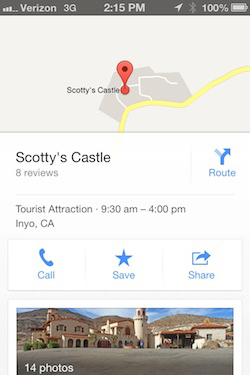 I wanted to save Scotty's Castle as a place of interest, so I just hit the search bar, typed in Scotty's Castle, and up it pops (see screen shot, right). Swipe up on the name Scotty's Castle in the bar at the bottom, and it gives you a menu of buttons—Call, Save, Share. Hit Save, and it puts it into your Google Places.
I wanted to save Scotty's Castle as a place of interest, so I just hit the search bar, typed in Scotty's Castle, and up it pops (see screen shot, right). Swipe up on the name Scotty's Castle in the bar at the bottom, and it gives you a menu of buttons—Call, Save, Share. Hit Save, and it puts it into your Google Places.
On this screen you can also browse things like photos, hours, reviews, distance from current location, and other useful information.
Then, next time I'm in Death Valley area, and I want to see if it's nearby, I fire up Google Maps app and any saved Places show up as yellow stars (see below).
I am trying to find out if the star colors can be changed, because the yellow is hard to see against the yellow roads. And they only show up at a certain zoom magnification.
The next screen-shot set below shows all the restaurants and cafes saved for Flagstaff, near Overland Expo. Click on a star and a pin pops up; click on the pin and you get the easy-to-read information popup at the bottom (swipe it up to see the details).
Ideally Google will eventually let us categorize and organize our Places, and edit them from either the app or through the Maps.Google.com. It would be nice to filter for things like restaurant, art gallery, museum, trail, or other category, to help minimize clutter if you have marked a lot of places in one area.
But otherwise it looks like it's going to be a very useful tool for travel anywhere.
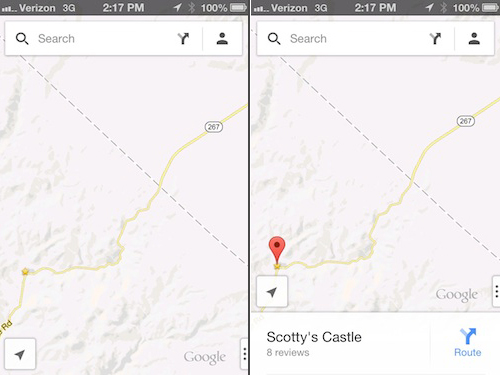
 Google Maps app is great for storing places you want to visit, like these restaurants and cafes in Flagstaff, near Overland Expo.
Google Maps app is great for storing places you want to visit, like these restaurants and cafes in Flagstaff, near Overland Expo.
iPhone Lifeproof Case, part 2
 At work on a recent volunteer project in Maasailand.
At work on a recent volunteer project in Maasailand.
After using the Lifeproof Case for iPhone 4S for over a month of travels—from the cold, wet climes of England and Scotland, to the hot, dusty world of Kenya's South Rift Valley (see Part 1)—the jury is in: two thumbs-up.
The iPhone is an indispensible tool for our work: I use it increasingly for daily snapshots for our Flickr and social media feeds; it's my only GPS tool; the currency calculator and various language dictionaries are fantastic for travel; and oh yes, it's a global phone, too (Verizon Wireless in the U.S. will unlock your iPhone, and you can purchase local micro-SIMs in most major destinations; I just find the local Apple network dealer and head to the larger shops where I target the young, hip sales staff—in Kenya it took 15 minutes to buy and set up an iPhone SIM and have data and voice for a month for $20).
The Lifeproof Case is the best case I've used so far, including the Otterbox and a Sea to Summit soft case, which really isn't suited to daily use. Minor gripes are that you have to use the Apple power cord only (I prefer the retractable cords from Ziplink) and the dongle for the headphones jack is a bit of a pain and quite prone to disappearing into the maw of my rucksack. Major gripe is that you will probably have to test 2-3 to get one that fits right and doesn't have a wobbly, useless plastic cover on the front.
I didn't test the 3 meter drop height, but I did drop the phone a couple times onto the talc-like dirt of the Rift Valley floor and was very grateful for the dustproof membranes and glass protecting the speaker and lenses.
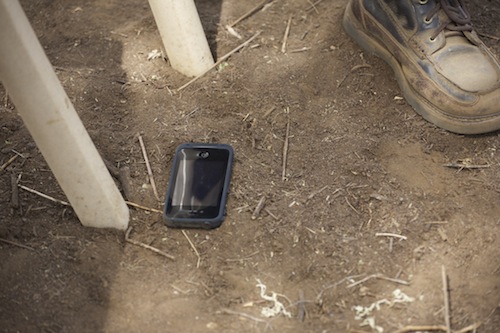 Oops. Dropping an expensive iPhone isn't so painful with the Lifeproof.
Oops. Dropping an expensive iPhone isn't so painful with the Lifeproof.
The Lifeproof Case is $80 but worth every penny to protect an expensive tool. Lifeproof.com
Hint: When using “Search,” if nothing comes up, reload the page, this usually works. Also, our “Comment” button is on strike thanks to Squarespace, which is proving to be difficult to use! Please email me with comments!
Overland Tech & Travel brings you in-depth overland equipment tests, reviews, news, travel tips, & stories from the best overlanding experts on the planet. Follow or subscribe (below) to keep up to date.
Have a question for Jonathan? Send him an email [click here].
SUBSCRIBE
CLICK HERE to subscribe to Jonathan’s email list; we send once or twice a month, usually Sunday morning for your weekend reading pleasure.
Overland Tech and Travel is curated by Jonathan Hanson, co-founder and former co-owner of the Overland Expo. Jonathan segued from a misspent youth almost directly into a misspent adulthood, cleverly sidestepping any chance of a normal career track or a secure retirement by becoming a freelance writer, working for Outside, National Geographic Adventure, and nearly two dozen other publications. He co-founded Overland Journal in 2007 and was its executive editor until 2011, when he left and sold his shares in the company. His travels encompass explorations on land and sea on six continents, by foot, bicycle, sea kayak, motorcycle, and four-wheel-drive vehicle. He has published a dozen books, several with his wife, Roseann Hanson, gaining several obscure non-cash awards along the way, and is the co-author of the fourth edition of Tom Sheppard's overlanding bible, the Vehicle-dependent Expedition Guide.

 ADVENTURE MOTORCYCLE MAGAZINE
ADVENTURE MOTORCYCLE MAGAZINE 



